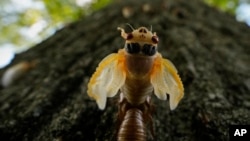Trillions of cicadas that have burrowed underground for 13 and 17 years are now emerging in parts of the midwestern and southern United States.
“The southern states and the central U.S. are going to be the hardest hit,” says Paula Shrewsbury, an entomologist at the University of Maryland. “They will have trillions of cicadas.”
The 13-year cicadas, Brood XIX, are found in Georgia, Tennessee, the Carolinas and elsewhere in the Southeast. Brood XIII, the 17-year cicadas, emerged primarily in Illinois. Periodical cicadas, which stay underground for years and then emerge together, are only found in the United States.
“That's one of the big mysteries as to why these cicadas evolved really long life cycles, among the longest among all insects,” says Floyd Shockley, an entomologist at the Smithsonian’s National Museum of Natural History, adding that it could be a reaction to radical temperature changes long ago.
“The last few ice ages, which would have happened after Magicicada evolved, may have forced them to have longer life cycles in order to survive periods of time when their host trees would have been impacted by glaciers,” he says.
Watch:
The cicadas spend their years underground as nymphs feeding on the sap from trees until it's time to rise, which occurs when the ground temperature reaches about 17 degrees Celsius [64 degrees Fahrenheit].
“That first night, their only goal is to molt into the adult,” Shockley says. “It takes them several hours to complete this process. They usually start at dusk and do most of this at night to avoid predators. It's not a very effective strategy, but when you're coming out in the millions or hundreds of millions, you don't really have to worry too much about surviving … there's still plenty [of cicadas] for the reproductive phase.”
After a few days, the mating dance begins. The male cicadas gather in trees and start singing to attract the females, who will signal if they are interested.
“She will flick her wings, and he will mate her. And once she's mated, he inserts what’s called a copulatory plug, which plugs the female so that other males can't mate her,” Shrewsbury says. “But then he gets to go on and find other females to mate with.”
Mating can last from a few hours to up to a day. Once mated, the females start creating slits in tree branch stems where they will lay 400 to 600 eggs before they die.
All of the cicadas will live above ground for only four to six weeks, just long enough to mate and lay their eggs before a massive adult die-off. The eggs left behind hatch about six to eight weeks later. The hatched nymphs drop to the ground and burrow beneath the dirt to begin the cycle all over again.
While cicadas might be a nuisance to some, the scientists say they have ecological benefits and don’t harm people or animals. For example, the millions of skins that are shed break down, and this organic matter is recycled back into the ground.
“And when they come up out of the ground, they burrow these holes, and those holes will add aeration holes for the roots of the plants. And water infiltration will be better, so it will help the plants to grow better,” Shrewsbury says.
The insects are also a nutritious food source for animals.
“We see a lot of feeding by, especially birds, but also mammals and reptiles that take advantage of the abundant food source,” Shockley says. “Everywhere the cicadas emerge, there's a flush of population growth in those predators. And so, they'll have a very good season. And then, of course, their populations will reduce back down naturally when that abundant food source disappears.”
Cicadas can also be a food source for humans. There are recipes for everything from stir-fried cicadas to cicada tacos and cicadas dipped in chocolate. Both Shrewsbury and Shockley have sampled them.
“Cicadas kind of have this kind of nutty taste to it, but they’re very nutritious,” she says. “Insects in general are very nutritious.”
“Most people prefer to go ahead and take the wings off and the legs off,” Shockley says. “Just because, I don't know why, they think maybe that's a little less creepy. But they're delicious.”







